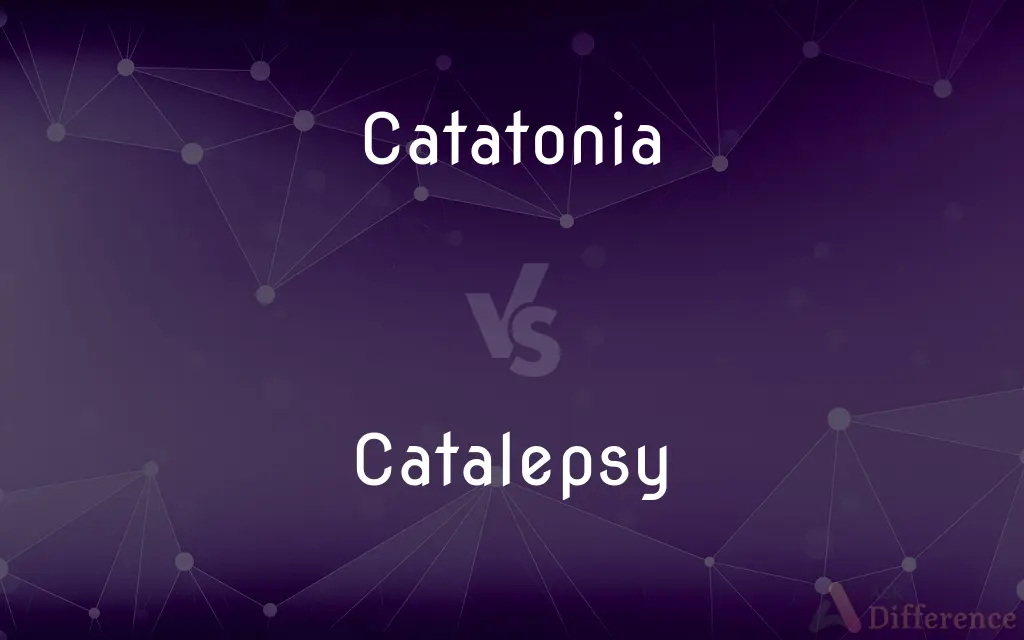Catatonia vs. Catalepsy — What's the Difference?
By Fiza Rafique & Urooj Arif — Updated on April 3, 2024
Catatonia involves a wide range of movement disorders and behavioral abnormalities, linked to psychiatric conditions. Catalepsy is characterized by muscular rigidity and lack of response to external stimuli, associated with certain neurological disorders.

Difference Between Catatonia and Catalepsy
Table of Contents
ADVERTISEMENT
Key Differences
Catatonia is primarily associated with psychiatric disorders such as schizophrenia, featuring symptoms like stupor, mutism, and rigidity. Patients may remain immobile or have purposeless movements. Whereas catalepsy, often related to Parkinson's disease or epilepsy, is marked by an unusual maintenance of limb positions for extended periods and a diminished response to stimuli.
While catatonia can present with a variety of symptoms including agitation, grimacing, or echolalia (repeating others' words), it fundamentally disrupts voluntary movement and can vary from hyperactivity to immobility. On the other hand, catalepsy is more uniform in presentation, with the patient exhibiting a wax-like flexibility allowing limbs to be positioned by another person and remaining that way.
Patients experiencing catatonia may also exhibit waxy flexibility, where they maintain positions after being placed there by someone else, but this symptom overlaps with catalepsy. However, catalepsy does not encompass the wide range of behavioral symptoms seen in catatonia, such as mutism or negativism (resistance to instructions).
The treatment for catatonia often includes benzodiazepines and electroconvulsive therapy, aiming to reduce severe symptoms and improve voluntary movement. Catalepsy treatment focuses on underlying causes, like adjusting medications for Parkinson’s disease or treating epilepsy, to alleviate the symptoms.
Diagnosis of catatonia involves observing the patient’s behavior and psychiatric evaluation, considering it often occurs alongside mood or psychotic disorders. Catalepsy's diagnosis, however, relies more on the physical manifestation of muscle rigidity and the patient’s medical history, highlighting its neurological basis.
ADVERTISEMENT
Comparison Chart
Primary Association
Psychiatric disorders like schizophrenia
Neurological disorders like Parkinson's disease and epilepsy
Symptoms
Stupor, mutism, rigidity, agitation, echolalia
Muscular rigidity, maintenance of limb positions
Treatment
Benzodiazepines, electroconvulsive therapy
Treatment of underlying cause, medication adjustments
Diagnostic Criteria
Behavioral observation, psychiatric evaluation
Physical symptoms, medical history
Characteristic Features
Behavioral abnormalities, movement disorders, wide symptom range
Muscular rigidity, lack of response to external stimuli
Compare with Definitions
Catatonia
A behavioral syndrome marked by an inability to move normally, associated with psychiatric conditions.
The patient with catatonia remained in the same position for hours, unresponsive to verbal commands.
Catalepsy
A medical condition characterized by muscular rigidity and a lack of response to external stimuli, related to neurological disorders.
The catalepsy episode left her arms suspended in the air, unaffected by attempts to move them.
Catatonia
The inability or refusal to speak, often seen in catatonic patients.
Despite repeated attempts to engage him in conversation, his catatonia-induced mutism was evident.
Catalepsy
The stiffening of muscles, making limb movement difficult or impossible, seen in catalepsy.
Muscular rigidity during his catalepsy made it impossible to comfortably reposition his limbs.
Catatonia
A state of near-unconsciousness or insensibility, prevalent in catatonic states.
The catatonic stupor made him oblivious to his surroundings, lying motionless on the bed.
Catalepsy
Managing catalepsy involves addressing the root neurological disorders.
Adjusting his Parkinson’s medication helped reduce the frequency of his catalepsy episodes.
Catatonia
A condition where the patient's limbs remain in the position they are placed, characteristic of catatonia.
Her waxy flexibility was a clear indicator of catatonia, as her arm stayed raised long after the doctor positioned it.
Catalepsy
A hallmark of catalepsy, where patients do not react to external stimuli.
Even when called by name or touched, she showed a complete lack of response due to catalepsy.
Catatonia
Exhibiting restless and often aggressive movements, sometimes observed in catatonic patients.
His catatonia was marked by periods of intense agitation, where he would suddenly start pacing and muttering.
Catalepsy
Patients with catalepsy can maintain any given limb position for an extended period.
After positioning her hand upward, it remained so for hours, demonstrating catalepsy's effect.
Catatonia
Catatonia is a neuropsychiatric behavioral syndrome that is characterized by abnormal movements, immobility, abnormal behaviors, and withdrawal. The onset of catatonia can be acute or subtle and symptoms can wax, wane, or change during episodes.
Catalepsy
Catalepsy (from Ancient Greek katálēpsis, κατάληψις, "seizing, grasping") is a nervous condition characterized by muscular rigidity and fixity of posture regardless of external stimuli, as well as decreased sensitivity to pain.
Catatonia
A psychological condition marked by severe decreases or increases of movement. It is variously characterized by stupor, stereotypy, mutism, catalepsy, agitation, and extreme flexibility or rigidity of the limbs and is most often associated with schizophrenia.
Catalepsy
A condition characterized by lack of response to external stimuli and by muscular rigidity, so that the limbs remain where they are positioned. It occurs in a variety of physical and psychological disorders, such as epilepsy and schizophrenia, and can be induced by hypnosis.
Catatonia
A severe psychiatric condition, often associated with schizophrenia, characterized by a tendency to remain in a rigid state of stupor for long periods which give way to short periods of extreme agitation.
Catalepsy
(pathology) A severe bodily condition, described in psychiatric pathology, marked by sudden rigidity, fixation of posture, and loss of contact with environmental conditions.
Catatonia
(informal) A frozen, unresponsive state, as of electronic equipment.
Catalepsy
A sudden suspension of sensation and volition, the body and limbs preserving the position that may be given them, while the action of the heart and lungs continues.
Catatonia
An abnormal behavioral syndrome characterized by stupor, negativism, and muscular rigidity, sometimes alternating with purposeless excitement, and seen most frequently in schizophrenia; called also catatonic schizophrenia.
Catalepsy
A trancelike state with loss of voluntary motion and failure to react to stimuli
Catatonia
Extreme tonus; muscular rigidity; a common symptom in catatonic schizophrenia
Catatonia
A form of schizophrenia characterized by a tendency to remain in a fixed stuporous state for long periods; the catatonia may give way to short periods of extreme excitement
Common Curiosities
Can catalepsy occur by itself?
While catalepsy is usually associated with neurological disorders like Parkinson’s disease, it can also appear transiently in otherwise healthy individuals under stress.
How is catatonia treated?
Treatment typically involves benzodiazepines and may include electroconvulsive therapy for severe cases.
What causes catatonia?
Catatonia is often caused by psychiatric disorders such as schizophrenia or mood disorders, including depression and bipolar disorder.
Is catalepsy a form of seizure?
No, catalepsy is not a seizure but rather a state of involuntary muscle rigidity and lack of response to stimuli.
What is the difference between catatonia and coma?
Catatonia involves abnormal movement and behavior but some awareness of the environment, unlike a coma, where there is no consciousness or response.
Are there different types of catatonia?
Yes, catatonia can manifest in various forms, ranging from extreme immobility (stupor) to excessive motor activity (agitated catatonia).
Can catatonia lead to complications?
Yes, without treatment, catatonia can lead to severe dehydration, malnutrition, and physical health issues due to prolonged immobility.
Can stress cause catatonia?
Yes, extreme stress and psychological trauma can trigger catatonia in some individuals.
How do doctors diagnose catalepsy?
Diagnosis is based on physical symptoms, patient history, and excluding other conditions with similar symptoms.
What triggers a catalepsy episode?
Triggers can include changes in medication for neurological diseases, severe psychological stress, or brain injuries.
Is catalepsy always permanent?
No, catalepsy is not always permanent; episodes can vary in duration and frequency, depending on the underlying cause.
Can children experience catatonia?
Yes, catatonia can occur in children, often associated with autism spectrum disorder or other psychiatric conditions.
Share Your Discovery

Previous Comparison
Overtake vs. Undertake
Next Comparison
Believe vs. DisbelieveAuthor Spotlight
Written by
Fiza RafiqueFiza Rafique is a skilled content writer at AskDifference.com, where she meticulously refines and enhances written pieces. Drawing from her vast editorial expertise, Fiza ensures clarity, accuracy, and precision in every article. Passionate about language, she continually seeks to elevate the quality of content for readers worldwide.
Co-written by
Urooj ArifUrooj is a skilled content writer at Ask Difference, known for her exceptional ability to simplify complex topics into engaging and informative content. With a passion for research and a flair for clear, concise writing, she consistently delivers articles that resonate with our diverse audience.














































